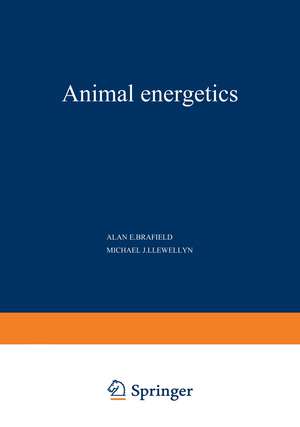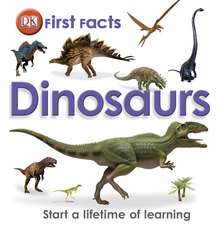Animal Energetics: Tertiary Level Biology
Autor Alan E. Brafield, Michael J. Llewellynen Limba Engleză Paperback – 27 dec 2012
Din seria Tertiary Level Biology
- 15%
 Preț: 637.59 lei
Preț: 637.59 lei -
 Preț: 381.00 lei
Preț: 381.00 lei -
 Preț: 382.95 lei
Preț: 382.95 lei -
 Preț: 379.86 lei
Preț: 379.86 lei -
 Preț: 381.59 lei
Preț: 381.59 lei -
 Preț: 387.20 lei
Preț: 387.20 lei -
 Preț: 362.82 lei
Preț: 362.82 lei -
 Preț: 386.99 lei
Preț: 386.99 lei -
 Preț: 382.18 lei
Preț: 382.18 lei - 15%
 Preț: 633.02 lei
Preț: 633.02 lei -
 Preț: 386.00 lei
Preț: 386.00 lei -
 Preț: 379.09 lei
Preț: 379.09 lei -
 Preț: 385.47 lei
Preț: 385.47 lei -
 Preț: 387.20 lei
Preț: 387.20 lei - 18%
 Preț: 721.01 lei
Preț: 721.01 lei -
 Preț: 387.38 lei
Preț: 387.38 lei -
 Preț: 384.48 lei
Preț: 384.48 lei -
 Preț: 382.95 lei
Preț: 382.95 lei -
 Preț: 351.90 lei
Preț: 351.90 lei -
 Preț: 381.59 lei
Preț: 381.59 lei -
 Preț: 382.36 lei
Preț: 382.36 lei -
 Preț: 380.07 lei
Preț: 380.07 lei - 15%
 Preț: 636.45 lei
Preț: 636.45 lei -
 Preț: 381.59 lei
Preț: 381.59 lei - 15%
 Preț: 660.18 lei
Preț: 660.18 lei -
 Preț: 390.84 lei
Preț: 390.84 lei -
 Preț: 384.31 lei
Preț: 384.31 lei -
 Preț: 385.62 lei
Preț: 385.62 lei -
 Preț: 384.86 lei
Preț: 384.86 lei -
 Preț: 385.08 lei
Preț: 385.08 lei -
 Preț: 378.92 lei
Preț: 378.92 lei -
 Preț: 384.70 lei
Preț: 384.70 lei -
 Preț: 404.67 lei
Preț: 404.67 lei -
 Preț: 381.00 lei
Preț: 381.00 lei -
 Preț: 394.71 lei
Preț: 394.71 lei -
 Preț: 376.96 lei
Preț: 376.96 lei -
 Preț: 382.18 lei
Preț: 382.18 lei -
 Preț: 379.09 lei
Preț: 379.09 lei -
 Preț: 382.18 lei
Preț: 382.18 lei - 15%
 Preț: 637.59 lei
Preț: 637.59 lei -
 Preț: 385.47 lei
Preț: 385.47 lei -
 Preț: 380.07 lei
Preț: 380.07 lei -
 Preț: 387.38 lei
Preț: 387.38 lei -
 Preț: 380.25 lei
Preț: 380.25 lei -
 Preț: 418.76 lei
Preț: 418.76 lei
Preț: 379.48 lei
Nou
Puncte Express: 569
Preț estimativ în valută:
72.61€ • 79.12$ • 61.19£
72.61€ • 79.12$ • 61.19£
Carte tipărită la comandă
Livrare economică 23 aprilie-07 mai
Preluare comenzi: 021 569.72.76
Specificații
ISBN-13: 9781468406511
ISBN-10: 1468406515
Pagini: 180
Ilustrații: VIII, 168 p. 3 illus.
Dimensiuni: 148 x 210 x 9 mm
Greutate: 0.21 kg
Ediția:Softcover reprint of the original 1st ed. 1982
Editura: Springer Us
Colecția Springer
Seria Tertiary Level Biology
Locul publicării:New York, NY, United States
ISBN-10: 1468406515
Pagini: 180
Ilustrații: VIII, 168 p. 3 illus.
Dimensiuni: 148 x 210 x 9 mm
Greutate: 0.21 kg
Ediția:Softcover reprint of the original 1st ed. 1982
Editura: Springer Us
Colecția Springer
Seria Tertiary Level Biology
Locul publicării:New York, NY, United States
Public țintă
ResearchCuprins
1. Energy and Energetics.- 1.1 Entropy, free energy and enthalpy.- 1.2 Work and heat.- 1.3 The study of energetics.- 2. The Energy Budget.- 2.1 The thermodynamic basis of the energy budget.- 2.2 Energy budget of an individual.- 2.3 Energy budget of a population.- 2.4 Energy flow in the ecosystem.- 2.5 The energy budget as a basis for the study of animal energetics.- 3. Energy Intake.- 3.1 The energy available to animals.- 3.2 Regulation of energy intake.- 3.3 Maintenance rations.- 3.4 Specific dynamic action.- 3.5 Bomb calorimetry.- 4. Energy Transformations within the Body.- 4.1 Adenosine triphosphate (ATP).- 4.2 Production of ATP.- 4.3 Muscle contraction.- 4.4 Biosynthesis.- 4.5 Active transport.- 5. Respiratory Rate and the Rate of Heat Loss.- 5.1 Direct and indirect calorimetry.- 5.2 Muscular activity and the energy cost of locomotion.- 5.3 Other sources of heat.- 5.4 Thermoregulation.- 6. Production.- 6.1 The energy cost of growth.- 6.2 Control of animal growth.- 6.3 The partitioning of energy between growth and reproduction.- 6.4 Strategies of reproduction.- 6.5 Growth and reproduction rates.- 6.6 The prediction of production from respiration and biomass data.- 7. Energy of Waste Products.- 7.1 Faeces.- 7.2 Urine.- 8. Energetics of Individuals and Populations.- 8.1 Energy budgets for individual animals.- 8.2 Energetic efficiencies.- 8.3 Production and consumption.- 8.4 Energy efficiency of an individual animal.- 8.5 Energy efficiency of a population.- 8.6 The construction and ecological value of population energy budgets.- 9. Ecosystem Energetics.- 9.1 Ecosystem energy models.- 9.2 Ecosystem efficiency.- 9.3 Lindeman’s study of Cedar Bog Lake.- 9.4 The energetics of Cone Spring.- 9.5 The transfer of energy between trophic levels.- 9.6 Changes in ecologicalenergy efficiencies at different trophic levels.- 10. Energy and Food Production.- 10.1 Energy and nutritional requirements of man.- 10.2 The energetics of grain production.- 10.3 The energetics of milk production.- 10.4 The energetics of fisheries.- 10.5 The overall energy efficiency of intensive agriculture.- References.




